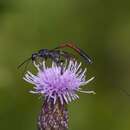en
names in breadcrumbs


The Gasteruptiidae are one of the more distinctive families among the apocritan wasps, with surprisingly little variation in appearance for a group that contains around 500 species in two subfamilies (Gasteruptiinae and Hyptiogastrinae) and with 6 genera worldwide. They are members of Evanioidea.
This family includes the following genera in two subfamilies:[1][2][3]
Several fossil species are also known:[4]
The propleura form an elongated "neck", the petiole is attached very high on the propodeum, and the hind tibiae are swollen and club-like. The females commonly have a long ovipositor (except in the genus Pseudofoenus), and lay eggs in the nests of solitary bees and wasps, where their larvae prey upon the host eggs, larvae and provisions. [5]
The absence of "teeth" on the crown of the head and the somewhat thickened antennae readily separate these wasps from those in the unrelated family Stephanidae, which also contains very slender wasps with long necks.
The smaller of the two gasteruptiid subfamilies, Hyptiogastrinae, has a restricted Gondwanan distribution. Hyptiogaster with 10 species is endemic to Australia, whereas of the 80 species of Pseudofoenus, most are found in Australia, with 2 species in New Zealand, 2 species in South America, 5 species in New Guinea and New Britain, and 3 species in the south-west Pacific (New Caledonia, New Guinea, Fiji and Vanuatu).
Gasteruption is worldwide in its distribution, whereas Plutofoenus, Spinolafoenus and Trilobitofoenus are found in South America.
 An Australian species in flight
An Australian species in flight The Gasteruptiidae are one of the more distinctive families among the apocritan wasps, with surprisingly little variation in appearance for a group that contains around 500 species in two subfamilies (Gasteruptiinae and Hyptiogastrinae) and with 6 genera worldwide. They are members of Evanioidea.